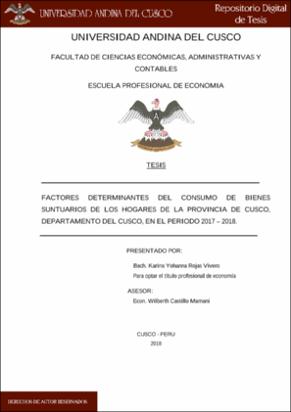| dc.contributor.advisor | Castillo Mamani, Wilberth | |
| dc.contributor.author | Rojas Vivero, Karina Yohanna | |
| dc.date.accessioned | 2019-03-01T20:33:50Z | |
| dc.date.accessioned | 2019-03-01T20:33:53Z | |
| dc.date.available | 2019-03-01T20:33:50Z | |
| dc.date.available | 2019-03-01T20:33:53Z | |
| dc.date.issued | 2018-11-22 | |
| dc.identifier.uri | https://hdl.handle.net/20.500.12557/2277 | |
| dc.description.abstract | En el presente trabajo se investigó los factores determinantes del consumo de bienes suntuarios
de los hogares de la provincia de cusco, departamento de Cusco, en el 2017 – 2018, para lograr
este objetivo se encuestó a 380 hogares de la provincia del Cusco, el objetivo general de la
investigación es conocer cuáles son los factores determinantes del consumo de bienes suntuarios,
el nivel de estudios es descriptiva longitudinal, con un diseño no experimental. La técnica de
recolección de datos que se implementó fue la encuesta con su respectivo instrumento el
cuestionario y los resultados fueron procesados en el sistema estadístico Spss Y Stata.
La principal problemática de la investigación es que se ha observado una tendencia a la compra
de bienes suntuarios, esto se da en todos los niveles socioeconómicos, y para personas que tienen
poder adquisitivo suficiente para comprar este tipo de bienes no afecta su condición de vida, sin
embargo para personas que tienen una restricción presupuestaria limitada, estas compras
suntuarias superfluas e innecesarias remplazaran el gasto en bienes de primera necesidad como
la educación, la salud, etc. A raíz del problema se determinó que los factores que determinan el
consumo de bienes suntuarios fueron ingreso, precio y la cantidad de miembros que conforma el
hogar, los resultados mostraron que el precio tiene relación positiva y el ingreso relación
negativa, sin embargo esta variable no explica en demasía el comportamiento del consumo en
este tipo de bienes, las características del hogar como es el tamaño del hogar tiene un relación
positiva, por lo que a medida que aumente el tamaño del hogar el consumo de bienes suntuarios
aumentará, pero solo hasta los 5 miembros, otra característica del hogar significativa es la edad
del jefe de hogar que de igual forma posee una relación positiva.
En el análisis de los resultados del 2018 se expone que en los primero 5 meses, el mayor gasto de
bienes suntuarios realizados por parte de los hogares fueron en televisores, seguidos de celulares,
pero esto se puede explicar por el precio, ya que a diferencia de estos el consumo en bienes de cuidado personal fueron los que menor gasto produjeron, sin embargo fue el bien que mayor
número de hogares lo consumieron, se menciona también las conclusiones derivadas de la
presente investigación y algunas recomendaciones . | es_PE |
| dc.description.abstract | In the this paper i investigated the determinants of the consumption of luxury goods of the
households of the province of Cusco, department of Cusco, in the 2017 - 2018, to achieve this
goal i surveyed 380 households in the province of Cusco, the objective The general research is to
know what are the determinants of the consumption of luxury goods, the level of studies is
descriptive longitudinal, with a non-experimental design. The technique of data collection that
was implemented was the survey with its respective instrument, the questionnaire and the results
were processed in the statistical system Spss and Stata.
The main problem of the research is that there has been a trend towards the purchase of luxury
goods, this occurs in all socioeconomic levels, and for people who have sufficient purchasing
power to buy this type of goods does not affect their living conditions, However, for people who
have a limited budget constraint, these superfluous and unnecessary sumptuary purchases will
replace spending on basic necessities such as education, health, etc. As a result of the problem it
was determined that the factors that determine the consumption of luxury goods were income,
price and the number of members that make up the household, the results showed that the price
has a positive relationship and the income negative relationship, however this variable does not It
explains too much the behavior of consumption in this type of goods, the characteristics of the
household such as the size of the household has a positive relationship, so that as the number of
household members increases the consumption of luxury goods will increase, but only Up to 5
members, another significant characteristic of the household is the age of the head of the
household who also has a positive relationship.
In the analysis of the results of 2018 it is exposed that in the first 5 months, the largest
expenditure of luxury goods made by households were on televisions, followed by cell phones,
but this can be explained by the price, since unlike of these consumption in personal care goods were those that produced the least expense, however it was the good that consumed the largest
number of households, the conclusions derived from this research and some recommendations
are also mentioned. | en_US |
| dc.description.uri | Tesis | es_PE |
| dc.format | application/pdf | es_PE |
| dc.language.iso | spa | es_PE |
| dc.publisher | Universidad Andina del Cusco | es_PE |
| dc.rights | info:eu-repo/semantics/openAccess | es_PE |
| dc.rights.uri | https://creativecommons.org/licenses/by-nc-nd/2.5/pe/ | es_PE |
| dc.source | Universidad Andina del Cusco | es_PE |
| dc.source | Repositorio Institucional - UAC | es_PE |
| dc.subject | Bienes suntuarios | es_PE |
| dc.subject | Consumo | es_PE |
| dc.subject | Necesidades básicas | es_PE |
| dc.title | Factores determinantes del consumo de bienes suntuarios de los hogares de la provincia de Cusco, departamento del Cusco, en el periodo 2017 – 2018. | es_PE |
| dc.type | info:eu-repo/semantics/bachelorThesis | es_PE |
| thesis.degree.name | Economista | es_PE |
| thesis.degree.grantor | Universidad Andina del Cusco. Facultad de Ciencias Económicas, Administrativas y Contables | es_PE |
| thesis.degree.level | Titulo Profesional | es_PE |
| thesis.degree.discipline | Economía | es_PE |


